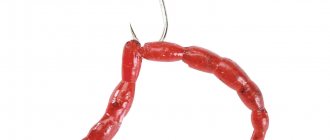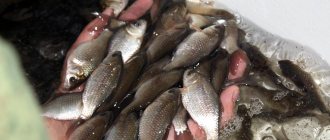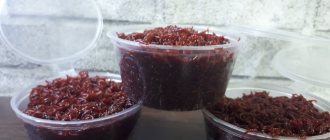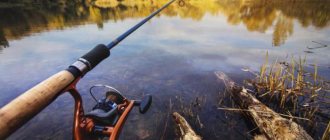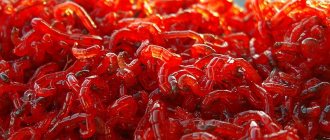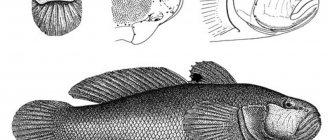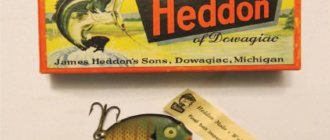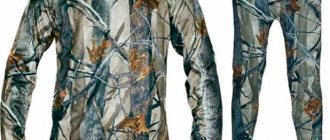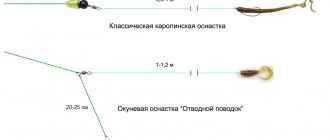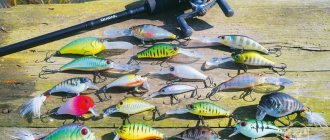Gelatin baits and baits: base and aromatics
The main ingredients for making baits are food gelatin and liquid glycerin. When combined together, depending on the proportions, they allow you to create a bait (bait) that has the required plasticity.
Additional components are dyes, flavors and attractants. You can use any food coloring, such as that used to color Easter eggs.
And the role of flavorings and attractants, depending on the goals, can be played by completely different additives:
- fish, shrimp, gammarus flour;
- special flavors and additives from a fishing store (worm, bloodworm, dried blood, crab, shrimp, etc., etc.);
- spices (vanilla, anise, cinnamon, coriander, garlic, cocoa, etc.).
Aromatic additives will help enhance the catchability of baits or baits, but pure gelatin is already a carrier of amino acids attractive to fish.
If you want to experiment with different flavors, it is added in liquid form to bags of ready-made unflavored edibles.
It is believed that predatory fish like salt, so you can add it too. And for peaceful fish, do not place a small amount of sugar. Both salt and sugar are natural flavor enhancers.
Features of use
But why do fishermen still choose such a bait as bait? And the answer is simple. In most stores it is difficult to purchase natural bloodworms when the first frost occurs. It appears on sale only when the first ice has hardened on the reservoirs. After this, it appears en masse on the shelves of fishing stores. Of course, you can get bloodworms yourself, but not all fishermen have the time for this and certain skills in getting it.
Also, the use of artificial bloodworms is associated with the unpretentiousness of storing the nozzle. Natural bloodworms freeze quickly in severe frost and deteriorate just as quickly in the summer heat. If you put natural bait on the hook incorrectly, it will quickly fly off it or be knocked down by the fish. This practically does not happen with an artificial nozzle.
Artificial bloodworms in stores are most often sold in jars (one hundred pieces in each) and come in two types: small and large. The size of the bloodworm also varies from 16 to 18 mm. The average price of a jar may vary depending on the manufacturer and the seller’s requests.
This bait is usually popular in the winter season; it is during this period that fishing with it is most effective. This is due to the fact that in winter the fish are not particularly picky about the proposed baits, as in the summer, and it is easy to deceive them with artificial bait.
Making edible material

- Take 10 g of gelatin, pour it into a glass, and immediately mix it with the dry ingredients (coloring, flavoring);
- Pour 25 ml of glycerin into the gelatin mixture and mix. Liquid attractant additives, if used, can be added at this stage.
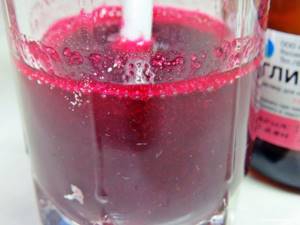
Place the resulting liquid mixture in a water bath and heat it to ~60 °C, and stir for 15 minutes:
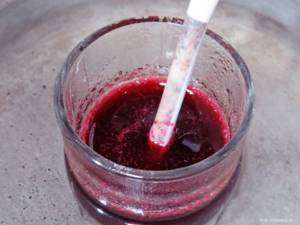
This will help the gelatin to disperse, and if the mixture is too thick, you can add another 5-10 ml of liquid glycerin (or warm water).
The liquid edible material is ready.
Features of fishing for roach and bream on artificial bloodworms
If our goal for fishing with artificial bloodworms is roach and bream, then we must determine the fishing horizon and select suitable flavors. The bream is a typical bottom-dwelling fish. Therefore, it is logical to catch it from the bottom. In winter, it is better to play slowly with frequent pauses. It is better to use anise, coriander and vanilla as a flavoring, or bloodworm scent.
Artificial nozzles are made of porous silicone, which absorbs liquids quite well. If the bite activator is oil-based, then the bloodworms soaked in them will smell for a long time. Practice shows that 2-3 flavored larvae may be enough for one fishing trip.
If we catch roach, it is important to determine the promising horizon. In winter, this fish often fishes in the lower layers, but can also be active in the upper levels of the water horizon. Here you need to slowly but surely raise the jig, loaded with an artificial bloodworm, to the selected length.
It is very useful to add a little dusty bait made from breadcrumbs. Fishing in such a cloudy cloud is very effective. Roachfish actively absorb food elements and sooner or later try the red bait.
Interestingly, larger roaches are caught on artificial bloodworms. For some reason, small specimens ignore this attachment. This is more of a plus than a minus. The fisherman thus selects the fish and catches only the best specimens. For roach, you can use a more active game, since in winter it often demonstrates the habits of a predator.
You should attach bloodworms for catching roach and bream in exactly the same way as when fishing for perch.
ribalka-vsem.ru
Manufacturing of artificial baits and lures
The simplest and fastest way to make imitation worms, bloodworms, maggots, and fry is cutting.
Pour the gelatin mixture onto the bottom of the plate, evenly distributing it over the bottom area (adjust the height of the layer to suit your needs):
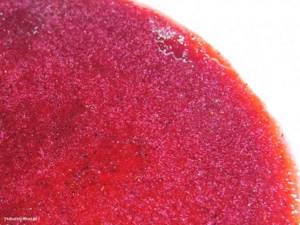
So that the hardened jelly mass can be easily separated, first grease the bottom of the plate with Vaseline (or, in extreme cases, vegetable) oil.
Once the mixture has hardened, you can start cutting:
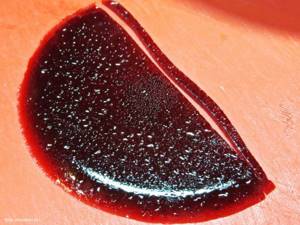
We cut to the maximum length, and when placing it on the hook, we pinch off the desired length.
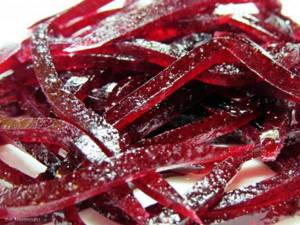
When everything is ready, we transfer our “worms” into a separate container with a lid or into a ziplock bag. To prevent them from sticking together, add a little Vaseline oil and shake.
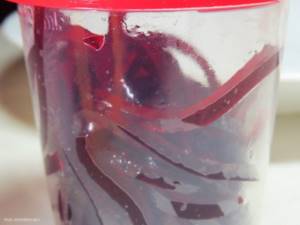
Now, everything can be put in the refrigerator.
Features of artificial bloodworms for fishing
A good alternative to live bloodworms is artificial ones. It is sold in small boxes and has already gained popularity among many anglers.
In appearance, artificial bloodworms are no different from living ones. It has the same bright red color with a black tint in some areas. Many artificial bloodworms have a persistent odor that closely resembles the natural one. These attachments are made of soft silicone. They are easily pierced in various points and do not interfere with hooking.
It is clear that artificial bloodworms will not work equally well on all reservoirs. It is important to understand that this attachment is not 100% working. At the same time, it makes sense to simply take it with you on fishing trips in order to be able to conduct experiments in various bodies of water.
Type and size of baits (attachments), their dissolution
By changing the cutting thickness you can make baits of different volumes. To replace vegetable attachments: barley, corn, peas, etc., you can make simple cubes using appropriate dyes and flavors.
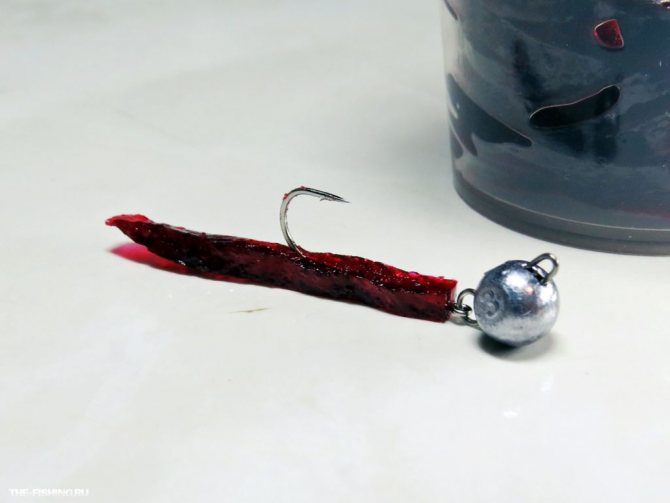
Realistic baits can be made by casting into a mold, but the process becomes more labor-intensive and time-consuming.
Dissolving artificial baits and baits:
- Once in the water, the edible will begin to slowly dissolve. On the one hand, this constantly releases the aroma, and on the other, it limits the working time of the bait.
- In water at room temperature, the bait almost completely dissolves in two hours. The thinner the bait and the warmer the water, the faster the dissolution process occurs.
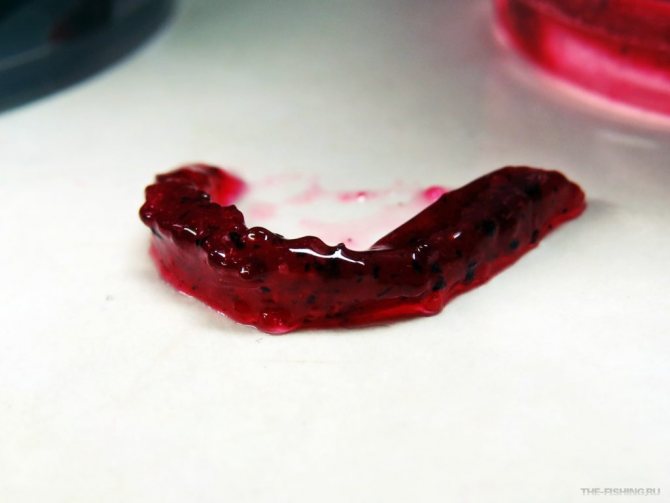
What's the result? As a result, we received an inexpensive alternative to branded artificial edible baits such as Berkley Blood Worms and the like, with the ability to select your own color, size and aroma of the bait.
It can be simpler
Take a red insulating wire (diameter 1.5 millimeters), cut off three rings - two 1 millimeter long and one 4 millimeters long. On the last segment, a triangular cut of 1.5 millimeters is made. First, small rings are pulled onto the hook, and then a large ring half the length. The entire structure moves close to the jig. The red wire can be replaced with yellow, the fish reacts very well to this color. In extreme cases, an ordinary balloon, cut into small strips, can also serve as a bloodworm. Artificial bait can be combined with real maggots. Author: Pike.Pinsk©
How to make bloodworms at home
4.4 (88.57%) 14 votes
How to get bloodworms
The largest number of mosquito larvae in the natural environment can be found in the silt of lakes and ponds, abundantly overgrown with bottom vegetation. They are also found in flowing bodies of water. Having determined the habitat, it is easy to wash bait for fish yourself.
The easiest way to do this is to use a fine sieve in which the bottom silt is rinsed. The soil is carried away with the water, and the larvae remain on the sieve. They are easy to collect with a fine-mesh net. Getting bloodworms will not be an insurmountable problem if you use a fork with a long handle and a thin metal wire wound around the teeth. It is tied with horizontal lines at intervals of 6-7 centimeters. By raking the constructed device along the bottom of the reservoir, you can easily catch mosquito larvae.
To learn more:
Rattlins for ice fishing for pike perch: top 5
The third method of extraction is even simpler - the silt is scooped up with a bucket and placed near a hot fire. Feeling the warmth, the bloodworm will float to the surface from which it is collected with a net.
The slowest, but quite effective method of obtaining larvae is to lower pieces of meat or fish wrapped in a gauze bag and loaded with heavy cobblestones to the bottom of the reservoir. In about a day, the trap will have a lot of bait.
How to wash bloodworms is up to each hunter to decide for himself. And to separate small specimens from large ones, just put them in a fine sieve and lower them into a container of water. Large prey will remain on the mesh, and small fry will leak out along with the liquid.
Technique for planting bloodworms
Insect larvae are a rather delicate product, sometimes they are smeared directly on the fingers. To keep the bait intact on the hook and make it appetizing to the fish, you should attach it correctly. There are the following options for placing bait:
- Hanging fresh bloodworm.
- Dressing the larva across.
- Impaling with a stocking or ring.
- Engaging baits with a beam.
The first method is used when fishing for medium-sized perches. The nozzle is placed on the finger and pierced with your free hand near the head so that the bloodworm hangs from the hook tip in the form of a thread. There is no need to hide the point, since it does not interfere with the fish. A correctly hooked larva remains viable in water for 8-10 minutes, after which it is advisable to replace it.
When fishing for roach, the bait is hooked across the sting. To do this, the bait is pierced not near the head, but in the middle. In the water column, a bait placed in this way makes oscillatory movements with both ends, attracting hungry fish.
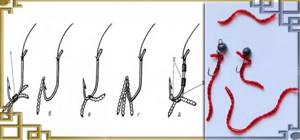
In its natural environment, the bloodworm curls up into a ring. In this position, the inhabitants of the underwater world find him. To make the bait on the hook look just as natural, it is taken by the back and pierced with a sting, forming a small ring. In a reservoir, such bait moves well, and it is more difficult for fish to pick it off.
The method of putting on a stocking is that the tip is inserted in the area of the head, but is not pushed out, but is pushed onto the sting with light turns until the end of the tail. The advantage of this method is that the fish will not be able to pull the bloodworm with impunity.
To learn more:
10 best wobblers for trout on paid sites
The technique of putting on larvae in a bunch is used in cases where bites from large individuals are expected. Several bloodworms are taken out of the bait storage container (for perch and roach 2-3 are enough, in the hope of catching bream you can use up to a dozen) and put them on the hook by the head. The advantage of this method is that a bunch of larvae release more juice and attract bottom inhabitants faster.
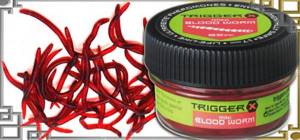
Advantages of fishing with a jig with a nozzle
A jig is a small bait that meets the needs of fish during the winter. Because of the cold water, the inhabitants of the reservoir show little activity and pay attention only to small prey. Larger baits are used in the warm season.
Thanks to its mobility, the jig imitates the behavior of various aquatic organisms in their natural habitat. Playing with a jig depends on the imagination and experience of the fisherman. Despite its small size, this bait creates water vibrations.
The fish's sensory organs, called lateral lines, detect these vibrations. As a result, the fish perceives the jig as a familiar living prey that lives in the reservoir. You can attach various fishing attachments to the jig hook. These can be animal, plant or artificial baits. Artificial baits imitate food items that fish are accustomed to eating.
There are also special jigs that are used for reelless fishing.
The jig is designed for catching large and small fish. Small ones can be used as live bait, which is installed on girders. If large specimens do not bite, then thanks to the jig you can count on a minimal catch, because it is better to return home with small fish than without anything.
Fishing differs from fishing with a jig in that you can be left completely without prey.
The advantage of a jig over a hook separated from the sinker is that a direct connection is established between the bait and the bite alarm (nod). Even a weak fish bite is instantly transmitted to the nod.
A jig, unlike a simple hook, can be tied to a fishing line in different ways. The performance of the bait will largely depend on how the angler tied it.
